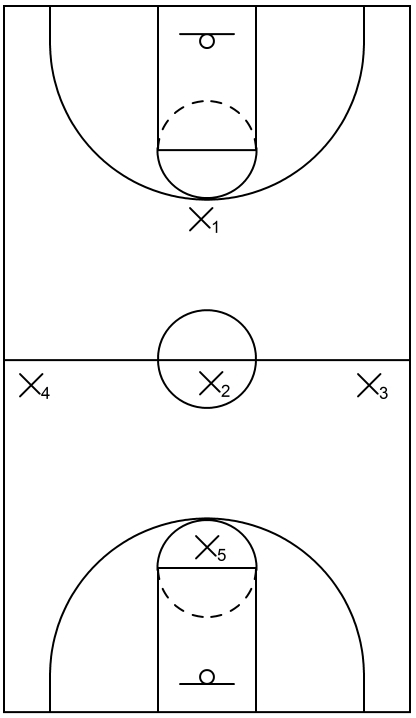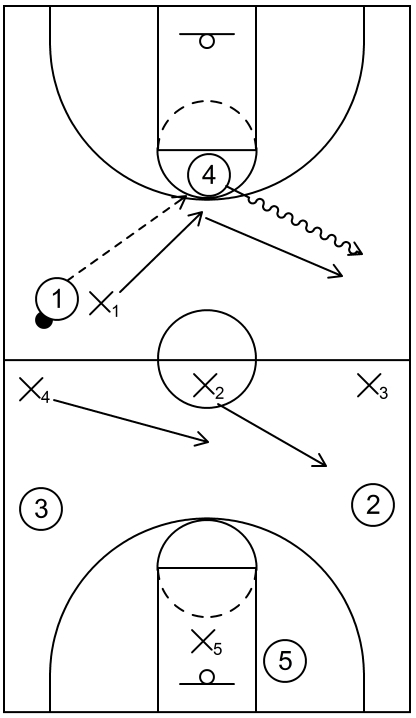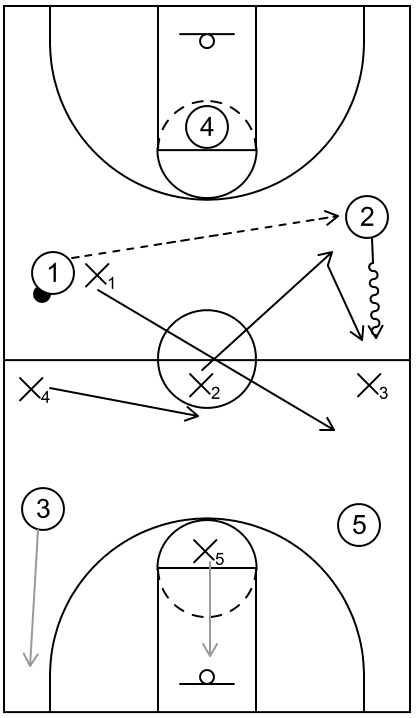What is the 1-3-1 press defense in basketball
The 1-3-1 press defense is a type of basketball defensive strategy that implements on-ball pressure, particularly in the backcourt, and traps near the sidelines, especially in the frontcourt, to limit or prevent offensive scoring opportunities.
What is an example of the initial formation for the 1-3-1 press defense

This is an example of the initial formation for the 1-3-1 press. In the backcourt, X1 starts at the top above the three-point line.
In the frontcourt, X2 starts near the half court center circle. Also, X3 and X4 start near the half court corners while X5 starts near the high post area.
What are the general responsibilities of the defenders within the 1-3-1 press defense
The responsibilities of X1 are to execute initial backcourt defensive pressure, influence the player in possession of the ball to dribble towards the sideline, set traps, particularly in the frontcourt, and in some instances, protect the middle of the court.
The responsibilities of X2 are to protect the middle of the court, deny frontcourt entry passes towards the wing or middle, and set traps near the sideline. The responsibilities of X3 and X4 are to set traps near the sidelines or protect the middle of the court.
The responsibilities of X5 is to cover the high post area in the frontcourt or protect the basket, especially if one or more offensive players cut below the free throw line extended area in the frontcourt.
What is an advantage of 1-3-1 press defense
One particular advantage of the 1-3-1 press defense is that it has the capability of creating defensive pressure but at the same time, the defensive team does not necessarily have to aggressively focus on generating offense from defense, primarily via live-ball turnovers unlike a few other types of press defenses.
To put it simply, the 1-3-1 press defense is more or less a containment-type press that seeks to disrupt the rhythm and flow of the offensive team and force them to execute several passes as they attempt to break the press.
It is also from these extra passes that could lead to possible turnovers as every additional pass increases the chances of the offensive team making mistakes.
However, as mentioned previously, the general emphasis is not necessarily on the turnovers themselves, but on disrupting the offensive flow first.
What is a disadvantage of 1-3-1 press defense
One general disadvantage of the 1-3-1 press defense is that there is only one defender at the bottom of the press to protect the basket.
So, if the offensive team is able to pass through the front-line defense at the top and in the middle, then the lone defender in the frontcourt may become vulnerable.
Especially if the offensive team creates a numbers advantage that occurs when there are two or more players available to score near the basket.
What are examples of the 1-3-1 press defense
Example 1

This is an example of the 1-3-1 press defense that demonstrates the defensive action prior to the sideline trap.
To start, 1 receives the inbound pass from 4 and following that, X1 influences 1 to dribble towards the sideline via defensive pressure.
As that occurs, X2 begins to slide over towards the ball side near the frontcourt wing area while X3 cuts to the middle of the court. Also, X5 covers the high post area.
However, if an offensive player such as 5 cuts below the free throw line extended, then X5 could drop back into the lane to protect the basket. This is shown on the diagram with gray arrows.
Example 2

This is an example of the 1-3-1 press defense that demonstrates a sideline trap once the ball enters into the frontcourt.
To begin, X1 and X4 set the trap near the sideline and at the same time, X2 denies the possible pass to the wing area while X3 denies the pass towards the middle. Also, X5 continues to protect the basket.
Example 3

This is an example of the 1-3-1 press defense that features a sideline trap near the wing/corner area. To start, X2 and X4 set the trap and as that occurs, X1 denies the potential pass to 1.
Also, X3 covers the middle of the press near the top of the three-point line while X5 continues to protect the basket.
Example 4

This is an example of the 1-3-1 press that features backwards passing in the backcourt. To start, 1 sees the trap in advance and proceeds to pass the ball backwards to 4.
Next, on the flight time of the pass to 4, X1 quickly executes a defensive closeout and afterwards, X1 influences 4 to dribble towards the sideline.
Additionally, X2 cuts towards the ball side wing area and X4 slides over to protect the middle area. Furthermore, X5 continues to protect the rim if there is at least one offensive player below the free throw line extended area.
Example 5

This is an example of the 1-3-1 press that shows 2 receiving a skip pass from 1 in the backcourt before the initial trap occurs.
When that happens, X1 probably will not have enough time to perform a defensive closeout on the ball.
Therefore, X2 could execute the closeout instead and influence 2 towards the sideline, which could lead to a possible trap.
At the same time, X1 then sprints across the court to deny a potential pass towards the ball side wing area while X4 slides across to cover the middle area that was recently vacated.
Also, X5 could cover the high post area or drop back towards the basket if one or more of the offensive players cuts below the free throw line extended, as represented by the gray arrows.
What are comparable defensive strategies in relation to the 1-3-1 press defense
The 1-1-2-1 press defense is a full court press that utilizes defensive pressure in the backcourt and afterwards, defensive players set sideline traps in the frontcourt, typically near the half court area to create potential turnovers.
The 1-1-3 press defense is a full court press that implements ball pressure in the backcourt and defensive traps in the frontcourt.
The 1-2-1-1 press defense is a full court press that could be implemented by teams with speed, quickness and very good conditioning with the main purpose of creating turnovers via traps set in the backcourt.
The 1-2-2 press defense features a variety of traps in the backcourt as well as the frontcourt, which could then lead to limited offensive scoring opportunities or potential turnovers.
The 2-1-2 press defense implements defensive traps near the sidelines to disrupt the scoring effectiveness of the offensive team with the additional possibility of creating turnovers.
The 2-2-1 press seeks to create quick turnovers or limit offensive scoring options with a primary backcourt trap and a secondary frontcourt trap.
The havoc press is a variation of the 1-2-1-1 press and it was popularized by Coach Shaka Smart, particularly during his time as the head coach of the VCU Rams men’s basketball team.